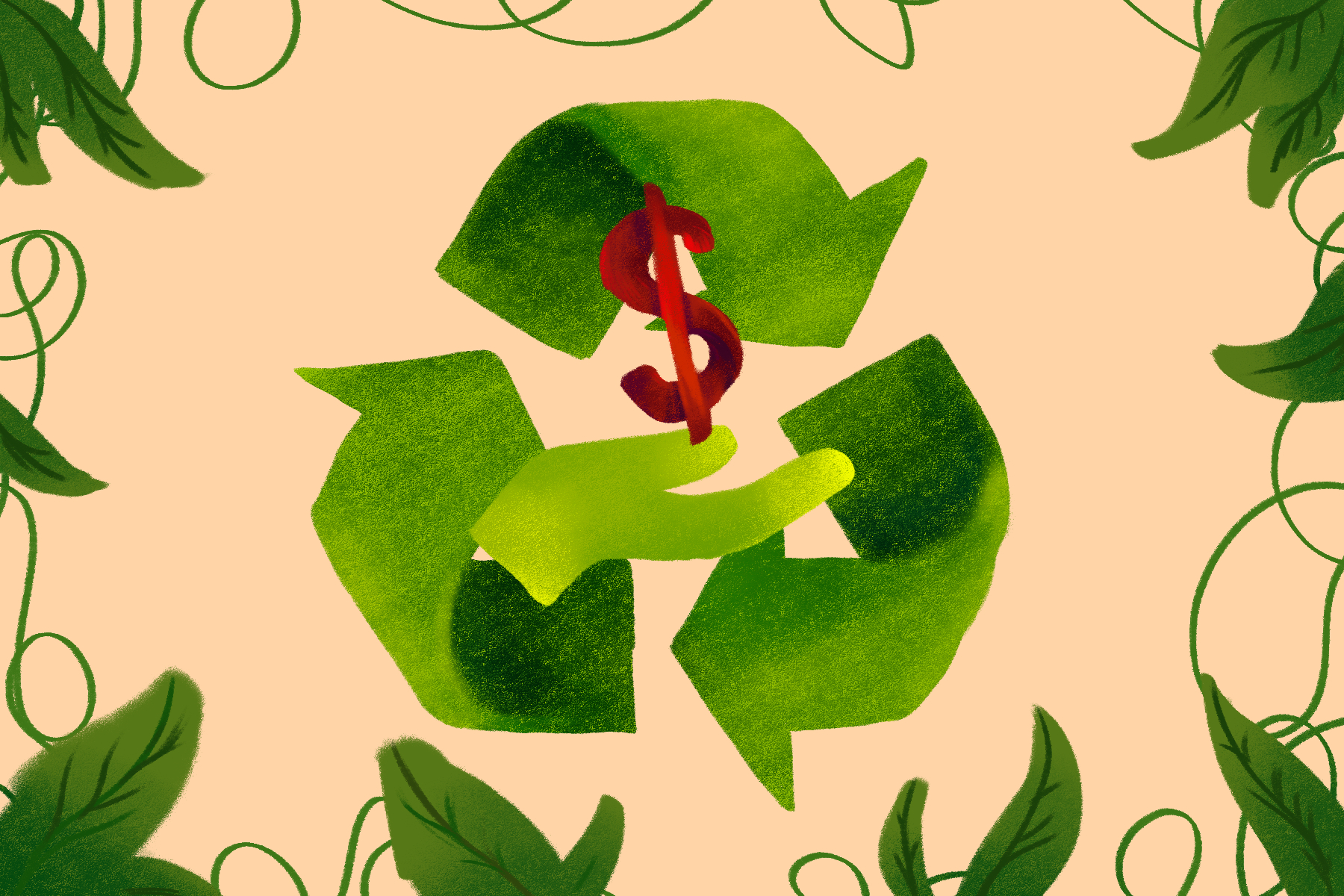The growing presence of the green movement on social media and other public platforms has convinced many people to join the sustainability lifestyle. Instagram‘s sustainable living influencers seem to be gaining followers by the day, and many companies have started to make the switch to green. With a number of people working toward these sustainability goals, many innovative products have started to surface. But here’s the catch: Many of these products have outrageously high prices.
The Greenwashing Factor
At its core, living sustainably simply means that a person is dedicated to reducing the amount of trash produced and is willing to take the extra steps to reduce general wastefulness. This fairly simple philosophy is widely seen as a positive endeavor; however, there are many who would seek to exploit it. This is formally known as “greenwashing.”
Leyla Acaroglu at Disruptive Design explained the phenomenon, “When companies invest more time and money on marketing their products or brand as ‘green’ rather than actually doing the hard work to ensure that it is sustainable — this is called greenwashing.” This misrepresentation of products is unfortunately common and far from a new occurrence.
CBS News even put out an article back in 2019 that stated, “‘Eco-friendly’ or ‘sustainable’ branding is increasingly used as a marketing strategy to distinguish products as premium or elite, making them almost certain to appeal to wealthier shoppers.”
With the growing pushback from the green community, it is important to understand that not every company is greenwashing. In an article from Scientific American Magazine, Ruth Markell outlined the difference between a greenwashing company and a sustainable company, and she provided tips on what to look for.
The added practice of greenwashing creates confusion for those shopping for eco-friendly materials. People generally don’t enjoy being lied to, and most shoppers — regardless of economic class — expect to receive what they pay for. Sustainable products are already expensive due to the higher cost of production of green material.
For more information, here is an article outlining the cost comparison of everyday items.
The Products Are Too Expensive — What Now?
Here’s the simple answer: Don’t buy them.
Greenwashed or not, the everyday danger related to these influencers’ promotion of sustainability is subtle, and it often preys on those who hold the idea that sustainability must look exactly like those cute Instagram photos. “As awful as it may sound, by nature, humans are attracted to a pleasant lifestyle. Greenwashing convinces us that we need a green alternative (or two) for every single product we should give up,” wrote Marine Leclerc in her article “Sustainable Living Is Expensive – Ending the Myth.”
In Leclerc’s article, she wrote against the comfortable lifestyle that is being advertised through social media. There is a disconnect between genuine sustainability and the highly romanticized, pinnacle-of-morality — the “only buy high-quality items from ethical businesses” type of lifestyle. Naturally, the directive not to buy isn’t intended to tell people who desire a lifestyle like those in the photos that buying these products is inherently wrong. Rather, Leclerc asserted that middle and lower-class families generally can’t afford to live this extravagantly, and a life of sustainability should not require a full-home makeover that includes exclusively eco-friendly products.
With the vast amount of innovative, green products, there is a push on social media to popularize these new materials. Like many other experimental, trending products, they are likely overpriced, and there is no guarantee that they are even effective. This is why there are many other activists that live their lives reusing old items rather than buying green products.
Aside from the misrepresentation of how these sustainable products are marketed, there also seems to be a vast number of people who are unfamiliar with the way these new, green products are meant to be used.
In the article “What Is The Difference Between Biodegradable And Compostable Goods?” Audrey Stanton wrote, “As the reality of the world’s waste problem becomes more evident, businesses have tried, time and again, to provide consumers with easy solutions. Many of these so-called fixes, however, have only created more waste.” This article was written in response to the number of biodegradable materials that are rendered useless from not being disposed of correctly. Articles like this help reestablish that simply buying green products is not a magic fix, and avoiding the purchase of new, especially disposable, materials should be avoided.
Common Green Products and How To Live Without Them
Reduce, reuse, recycle.
The three Rs are fairly well known in the green community, and it is important to keep them in mind when considering whether or not to buy a product. The following items aren’t necessarily bad, in terms of the ideas behind them — but they are generally expensive, and they don’t always meet the three Rs. Naturally, none of these ideas are meant to scare people away from buying new things. Every person needs to find the right balance between being kind to the Earth and being able to live comfortably.
The first easy way to embrace sustainability is to reuse clothing and fabric that is already owned. “Fast fashion” and “slow fashion” are common words in the community, implying that quality clothing is less wasteful and can be worn for longer periods without needing to be thrown out. But many of these brands are expensive, and those on a budget can’t always afford to make the switch from fast fashion to slow fashion.
Beth Porter, in her article “What Really Happens to Unwanted Clothes,” provided statistics on where clothing ends up in the United States. She explained that it’s better to buy clothing from secondhand stores instead of buying new. This is generally cheaper, and it reduces the clothing that is sent to landfills. Learning how to sew up holes and repair clothing can also be a great skill, as it saves money and makes the product last longer.
Bamboo cutlery and other kitchenware is also trending on social media, and for good reason. On its own, bamboo is a great alternative to metal, and it’s a beautiful material. And unlike slow fashion, bamboo is relatively inexpensive. It is also biodegradable. Even so, reusing materials in order to reduce the amount going into landfills is a good habit. If time permits, one can venture to see what yard sales and secondhand stores have to offer, since these locations will provide cheaper products than buying new.
Fancy composting bins can range anywhere from $20 to well over $100. These might look great on social media, but many families find it difficult to put this sort of money down for something as non-essential as a composting bin. An old box in the garage with a liner, or if time and funds allow, a wooden composting box outside would perform the same function.
Reusable or cloth “paper” towels are also unnecessary. Not only can these products be found at $40 or more when bought new, they are the same in almost every way to normal washcloths. A case could be made that they are biodegradable, but they are still adding material to the environment. Why not cut up an old rag or go buy an article of clothing for 50 cents at a yard sale to cut up? The cut-up rags might not look as pretty, but they will do the same thing. This goes for reusable napkins, facial cloths and other items that can be easily replaced with cheaper materials.
Uniform storage containers are also trendy on social media. There are plenty of influencers who love to boast about their sustainable kitchen organization, but the cost of these pretty glass jars can add up. Instead of buying new storage, reuse old glass jars and containers. This will allow for the same storage of non-perishable food — no doubt bought in bulk to reduce packaging. This same principle can be applied to plastic containers, which can be reused for storage and leftovers. There are also plenty of cute DIY tutorials on Pinterest and other social media sites that show how ugly containers can be made to look pretty and new again.

















